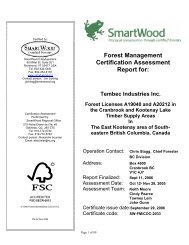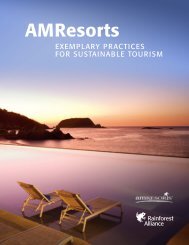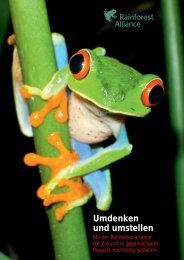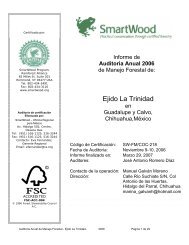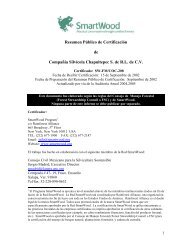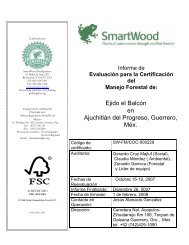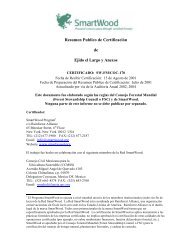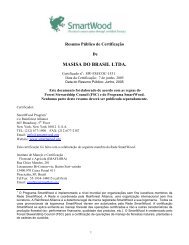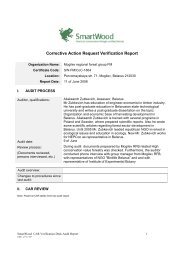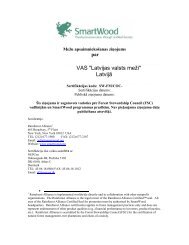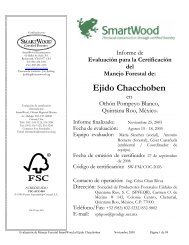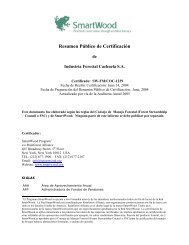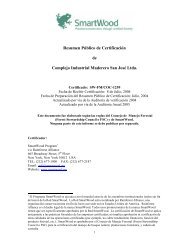Brinkman y Asociados Reforestadores de Centro América, SA
Brinkman y Asociados Reforestadores de Centro América, SA
Brinkman y Asociados Reforestadores de Centro América, SA
You also want an ePaper? Increase the reach of your titles
YUMPU automatically turns print PDFs into web optimized ePapers that Google loves.
Certified by:<br />
SmartWood Headquarters<br />
65 Millet St. Suite 201<br />
Richmond, VT 05477 U<strong>SA</strong><br />
Tel: 802-434-5491<br />
Fax: 802-434-3116<br />
www.smartwood.org<br />
Persona <strong>de</strong> contacto: Jon Jickling<br />
jjickling@smartwood.org<br />
Certification Assessment<br />
performed by:<br />
SmartWood Regional Office<br />
Central America and The Caribbean<br />
8a. Avenida 15-62, Zona 10,<br />
Ciudad <strong>de</strong> Guatemala, Guatemala<br />
Tel: (502) 2383-5757<br />
Fax: (502) 2383-5788<br />
Contact Person: Adolfo Lemus<br />
Email: alemus@smartwood.org<br />
ACREDITADO<br />
FSC-ACC-004<br />
© 1996 Forest Stewardship Council A.C.<br />
FM-02 Sept 2004<br />
Forest Management<br />
Re-certification Assessment<br />
Report for:<br />
BRINKMAN Y ASOCIADOS<br />
REFORESTADORES DE<br />
CENTRO AMÉRICA, S.A.<br />
(BARCA S.A.)<br />
In<br />
Puntarenas, Costa Rica<br />
Assessment Date: April 18th-22nd, 2006<br />
Draft Report: June 8 th , 2006<br />
Report Finalized: June 22th, 2006<br />
Assessment Team: William Arreaga,<br />
Hugo Álvarez<br />
Certificate issue date: June 21st, 2001<br />
Certificate co<strong>de</strong>: SW-FM/COC-152<br />
Operation Contact: Ricardo Luján M.Sc.<br />
Address: Apartado 80, Parrita (6300),<br />
Puntarenas, Costa Rica.
TABLE OF CONTENTS<br />
INTRODUCTION........................................................................................................................... 4<br />
1. SCOPE OF THE CERTIFICATE.................................................................................................. 5<br />
1.1. SCOPE OF THE CERTIFICATE ............................................................................................................ 5<br />
1.2. EXCLUSION OF AREAS FROM THE SCOPE OF CERTIFICATE ........................................................... 6<br />
2. ASSESSMENT PROCESS......................................................................................................... 7<br />
2.1. CERTIFICATION STANDARD USED .................................................................................................. 7<br />
2.2. ASSESSMENT TEAM AND QUALIFICATIONS..................................................................................... 7<br />
2.3. ASSESSMENT SCHEDULE .................................................................................................................. 7<br />
2.4. EVALUATION STRATEGY.................................................................................................................... 8<br />
2.5. STAKEHOLDER CONSULTATION PROCESS....................................................................................... 9<br />
3. ASSESSMENT FINDINGS AND OBSERVATIONS........................................................................ 11<br />
3.1. STAKEHOLDER COMMENTS RECEIVED........................................................................................... 11<br />
3.2. MAIN STRENGTHS AND WEAKNESSES........................................................................................... 14<br />
3.3. IDENTIFIED NON-COMPLIANCES AND CORRECTIVE ACTIONS..................................................... 19<br />
3.4. FOLLOW-UP ACTIONS BY CLIENT TO MEET CERTIFICATION........................................................ 20<br />
3.5. OBSERVATIONS ............................................................................................................................... 20<br />
3.6. RE-CERTIFICATION RECOMMENDATION ....................................................................................... 20<br />
4. CLIENT SPECIFIC BACKGROUND INFORMATION...................................................................... 22<br />
4.1. OWNERSHIP AND LAND TENURE DESCRIPTION............................................................................ 22<br />
4.2. LEGISLATIVE AND GOVERNMENT REGULATORY CONTEXT ........................................................... 24<br />
4.3. ENVIRONMENTAL CONTEXT............................................................................................................ 25<br />
4.4. SOCIOECONOMIC CONTEXT........................................................................................................... 26<br />
APPENDIX I: FSC Reporting Form: Detailed FMO information............................................................ 27<br />
APPENDIX II: Public Summary of the management plan .................................................................. 30<br />
APPENDIX III: Certification Standard conformance checklist (Confi<strong>de</strong>ntial) ......................................... 33<br />
APPENDIX IV: Chain of Custody Standard Conformance Checklist (confi<strong>de</strong>ntial) .................................. 72<br />
APPENDIX V: Group Certification Conformance:.............................................................................. 74<br />
APPENDIX VI: List of all visited sites (confi<strong>de</strong>ntal): ......................................................................... 78<br />
APPENDIX VII: Detailed list of stakehol<strong>de</strong>rs consulted (confi<strong>de</strong>ntial):................................................. 79<br />
ANEXO VIII: FMO Maps............................................................................................................... 81<br />
APPENNDIX IX: Documentation Reviewed...................................................................................... 84<br />
ANEXO X. CLIENT INFORMATION ................................................................................................ 85<br />
SmartWood Program– FM Assessment Report – BARCA S.A., Puntarenas, Costa Rica April 2006 Page 2
ACRONYMS<br />
ACO<strong>SA</strong> Conservation area of Osa<br />
B&A <strong>Brinkman</strong> and Associates Reforestation, Ltd.<br />
BARCA <strong>Brinkman</strong> y <strong>Asociados</strong> <strong>Reforestadores</strong> <strong>de</strong> <strong>Centro</strong> America S.A.<br />
HCVF High Conservation Value Forest<br />
BIRD <strong>Brinkman</strong> Internacional Reforestacion y Desarrollo S.A.<br />
AAC Annual Allowable Cut<br />
CAR Corrective Action Request<br />
CCSS Costa Rican Social Security<br />
CITES Convention on International Tra<strong>de</strong> of Endangered Species<br />
CNCF National Commission of Forest Certification<br />
COC Chain of Custody<br />
FONAFIFO National Fund for Forest Support<br />
FSC Forest Stewardship Council<br />
IDA Agricultural Development Institute<br />
INS National Insurance Institute<br />
MAG Ministry of Agriculture<br />
MINAE Ministry of Environment and Energy<br />
OBS Observation<br />
ITTO International Tropical Timber Organization<br />
ILO International Labor Organization<br />
FMO Forest Management Operation<br />
P&C Principles & Criteria of the FSC<br />
PSP Permanent Sampling Plot<br />
P<strong>SA</strong> Payment for Environmental Services<br />
PWC PWC Trust Consultants S.A.<br />
SETENA National Technical Department<br />
SW SmartWood Program of the Rainforest Alliance<br />
TV Terra Vitallis Foundation<br />
FMU Forest Management Unit<br />
SmartWood Program– FM Assessment Report – BARCA S.A., Puntarenas, Costa Rica April 2006 Page 3
INTRODUCTION<br />
This report presents the findings of an in<strong>de</strong>pen<strong>de</strong>nt certification assessment conducted by a<br />
team of specialists representing the SmartWood program of the Rainforest Alliance. The<br />
purpose of the assessment was to evaluate the ecological, economic and social sustainability of<br />
<strong>Brinkman</strong> y <strong>Asociados</strong> <strong>Reforestadores</strong> <strong>de</strong> <strong>Centro</strong> <strong>América</strong>, S.A. (BARCA) in the fincas<br />
located in Parrita, Aguirre, Golfito and Osa at the Province of Puntarenas, Costa Rica; as <strong>de</strong>fined<br />
by the Forest Stewardship Council (FSC).<br />
This report contains four main sections of information and findings and several appendixes. The<br />
whole report plus appendices I and II will become public information about the forest<br />
management operation that may be distributed by SmartWood or the FSC to interested parties.<br />
The remain<strong>de</strong>r of the appendices are confi<strong>de</strong>ntial, to be reviewed only by authorized<br />
SmartWood and FSC staff and reviewers bound by confi<strong>de</strong>ntial agreements.<br />
The purpose of the SmartWood program is to recognize conscientious land stewardship through<br />
in<strong>de</strong>pen<strong>de</strong>nt evaluation and certification of forestry practices. Forestry operations that attain<br />
SmartWood certification may use the SmartWood and FSC labels for public marketing and<br />
advertising.<br />
SmartWood Program– FM Assessment Report – BARCA S.A., Puntarenas, Costa Rica April 2006 Page 4
1. SCOPE OF THE CERTIFICATE<br />
1.1. Scope of the certificate<br />
<strong>Brinkman</strong> y <strong>Asociados</strong> <strong>Reforestadores</strong> <strong>de</strong> <strong>Centro</strong> <strong>América</strong> Sociedad Anónima (BARCA) is a<br />
Costa Rican company whose headquarter is located in Parrita, province of Puntarenas; a<br />
subsidiary of the Canadian company <strong>Brinkman</strong> and Associates Reforestation, Ltd. (B&A).<br />
BARCA is legally registered in the Civil Registry as Anonymous Society un<strong>de</strong>r the permit<br />
number 3-101-162768, issued on January 31st, 1995.<br />
Since the beginning, on 1994, BARCA has offered technical assistance regarding forest<br />
plantation management to third parties’ companies located in the Costa Rican Pacific Ocean;<br />
this is the case of the company Ma<strong>de</strong>ras Von Moos S.A. and of Mr. Kevin Yardley’s companies.<br />
Simultaneously, BARCA has managed plantations in fincas co-owned with <strong>Brinkman</strong><br />
Internacional Reforestación y Desarrollo S.A. (BIRD). The company’s forest management<br />
implemented in the fincas was evaluated by SW on 2000, obtaining the following year a FSC<br />
certificate as a Resource Manager (SW-FM/COC-152).<br />
Eventually a finca property of BARCA was inclu<strong>de</strong>d in the certificate (in the central Pacific) and<br />
others, located in the Central and the South Pacific, where BARCA co-owns with PWC Trust<br />
Consultants S.A. (PWC) and the Terra-Vitallis Foundation (TV). This foundation from the<br />
Netherlands hired BARCA to administrate and to regent Teak plantations, including the<br />
establishment, maintenance, management and harvesting activities until the final harvest on<br />
the 20 th year. Un<strong>de</strong>r this scheme the players acquire different responsibilities, on one hand<br />
TV gets interested parties to invest in the Teak plantations management, offering significant<br />
benefits at the short and long term. On the other hand, BARCA, as a resource manager, takes<br />
care of any activity consi<strong>de</strong>red valid to achieve those benefits. Here is where PWC takes<br />
action, administrating the fund created from the investors’ resources, and administrating the<br />
fund trust, which is the land itself, same that at the beginning of the relationship with the<br />
clients constitutes the guarantee that BARCA will comply with what is offered. In that way, at<br />
the end of the relationship (20 years), the land will again be registered to BARCA, as the<br />
exclusive owner.<br />
For certification purposes, since 2001 BARCA and the group member organizations (Kevin<br />
Yardley and Ma<strong>de</strong>ras von Moos) signed internal legal agreements, where it is established that<br />
BARCA will continue to offer technical advice and it will represent them before SmartWood<br />
(SW) as Resource Manager of the group certificate. These contracts were signed at different<br />
time and inclu<strong>de</strong> the commitment to renew them every five years.<br />
Given the previous certification background, it can be summarized that the scope BARCA’s<br />
certificate as a Resource Manager from the present day, will cover three big groups 1 , each one<br />
of them with a different number of fincas registered un<strong>de</strong>r its name and whose total extention<br />
adds up to 2,120.81 ha, from which 1,995.38 ha constitute the candidate area to be inclu<strong>de</strong>d<br />
in the certificate. From that total, about 20% is distributed in the certificated forest area<br />
property of Kevin Yardley (eight individual properties) and of Ma<strong>de</strong>ras Von Moos S.A. (four<br />
individual properties) and the remain<strong>de</strong>r is distributed among BIRD, PWC and BARCA (62<br />
individual properties).<br />
1 BARCA S.A. is not inclu<strong>de</strong>d as a group member; <strong>de</strong>tails are given in section 1.2.<br />
SmartWood Program– FM Assessment Report – BARCA S.A., Puntarenas, Costa Rica April 2006 Page 5
The scope of BARCA’s certificate, in terms of number of companies and fincas, number of<br />
registry of the companies and the area of the assessed fincas, is <strong>de</strong>scribed in Table 1, and the<br />
<strong>de</strong>tails of the individual properties of each group are in Table 2 (section 4.1 of this report).<br />
Table 1. Scope of BARCA’s certificate as a Resource Manager.<br />
FMU and<br />
certification<br />
subco<strong>de</strong><br />
BARCA/BIRD/PWC<br />
(SW-FM/COC-152-A)<br />
KEVIN YARDLEY<br />
(SW-FM/COC-152-B)<br />
MADERAS von MOOS<br />
(SW-FM/COC-152-C)<br />
Owner / Companies<br />
BARCA S.A.<br />
BIRD 96 S.A.<br />
BIRD 98 S.A.<br />
BIRD S.A.<br />
PWC Trust Consultants S.A.<br />
El Cangrejo y Pelícano S.A.<br />
Palos Tropicales S.A.<br />
Reforestadora Palo Bonito S.A.<br />
Ma<strong>de</strong>ras Duras Tropicales<br />
Diamante S.A.<br />
Ma<strong>de</strong>ras Tropicales Diamante<br />
Internacional. S.A.<br />
Bosque <strong>de</strong> Estrellas S.A.<br />
No. of Legal<br />
Registry<br />
3-101-162768<br />
3-101-178516<br />
3-101-178515<br />
3-101-157903<br />
3-101-261988<br />
3-101-189222<br />
3-101-189187<br />
3-101-153334<br />
3-101-190769<br />
3-101-189174<br />
3-101-250254<br />
Ma<strong>de</strong>ras von Moos S.A. 3-101-220711<br />
SOURCE: BARCA S.A., 2006 and www.registronacional.gob.cr<br />
Location<br />
South and Central<br />
Pacific:<br />
Cantones Parrita,<br />
Aguirre, Golfito and<br />
Osa, Puntarenas, Costa<br />
Rica.<br />
Central Pacific:<br />
Cantón Parrita,<br />
Puntarenas, Costa Rica.<br />
No. of<br />
fincas<br />
SmartWood Program– FM Assessment Report – BARCA S.A., Puntarenas, Costa Rica April 2006 Page 6<br />
Certificated<br />
area (ha)<br />
62 1,622.48<br />
8 202.25<br />
Central Pacific:<br />
Cantón Parrita,<br />
Puntarenas, Costa Rica.<br />
4 170.65<br />
TOTALS 74 1,995.38<br />
For the implementation of management practices in the new planted areas, BARCA has a regional<br />
office attending all forest projects located at Palmar Sur, Puerto Escondido and Golfito, toward the<br />
Pacific South of the country. The company, in this location, has all the nee<strong>de</strong>d facilities for<br />
expansion of forest projects (nursery area, storage area, and offices) and with the technical staff<br />
in charge of several tasks (topography, plantations establishment, soils, geographic information<br />
system, forest engineer, and administrative and financial staff). In appendix II and III of the<br />
current report, there is more <strong>de</strong>tailed information of the Forest Management Operation (FMO) and<br />
of the areas covered by the certificate.<br />
1.2. Exclusion of areas from the scope of certificate<br />
BARCA also implements the forest regency in finca Salamá, in the Canton of Osa, Puntarenas.<br />
The current forest activity in that finca is the harvest of trees’ remnants, or sprouts of Melina<br />
(Gmelina arborea), which was not managed by its previous owner. BARCA <strong>de</strong>ci<strong>de</strong>d not to<br />
inclu<strong>de</strong> this property within the group certification because it is uncertain whether it will be<br />
sold or will be used to <strong>de</strong>velop more plantation projects, probably un<strong>de</strong>r the present scheme<br />
of the Terra Vitallis Foundation. BARCA does not make certification claims in signs or public<br />
documents related to this property.<br />
In another matter, Finca Capital (54.89 ha, located in Parrita, Puntarenas), property of BARCA<br />
S.A. will be exclu<strong>de</strong>d from the scope of the certificate. The company expressed the reason of<br />
the exclusion obeys to the initial segregation from the original (also called Capital, with an<br />
extension of 64.50 ha, which will not be exclu<strong>de</strong>d from the certificate) and it is mostly covered<br />
with native forest, being this the reason why it will be sold at the short term.
2. ASSESSMENT PROCESS<br />
2.1. Certification Standard Used<br />
The certification assessment of BARCA S.A. was conducted by the assessment team using the<br />
SmartWood certification standards, modified and adapted to the Costa Rican conditions, just<br />
as it is <strong>de</strong>scribed in the Forest Management Assessment Interim Standard for Costa Rica (April<br />
2003). To assess the principle 10 (Plantations) the team used the SmartWood Generic<br />
Standards for Forest Plantation Management (version 2000).<br />
The criteria and interim standards are the official SmartWood certification procedures for<br />
Costa Rica and they are based on SmartWood Generic Standards (version 2000), which have<br />
been accredited by the FSC. The interim standards either achieve or exceed the requirements<br />
of the SmartWood Generic Standards. The operations achieving or exceeding these standards<br />
will be issued the SmartWood certification status.<br />
To obtain a copy of the standard used in the assessment, Adolfo Lemus, Regional Manager of<br />
the SmartWood Office for Central America and the Caribbean, could be contacted<br />
(alemus@smartwood.org).<br />
2.2. Assessment team and qualifications<br />
Hugo Álvarez: Costa Rican, Forest Engineer with over 16 years of experience in resource<br />
management projects. He has seven years of experience in training, evaluation and annual<br />
audit processes for SmartWood at Latin American level. Currently, he is the SmartWood<br />
representative for Costa Rica. During the present assessment he assessed the social and<br />
economic aspects of forest management.<br />
William Arreaga: Guatemalan; Alumni of the Agronomic Department of the Universidad <strong>de</strong><br />
San Carlos of Guatemala and has a Master of Science from CATIE. He has experience in the<br />
management of natural forests and plantations, as well as the assessment of tracking<br />
procedures of certified wood in industrial companies. Currently, he is a forest specialist in<br />
certification of forest management and chain of custody at the SmartWood regional office for<br />
Central America and the Caribbean. In the case of the re-assessment process of BARCA, he<br />
led the team and assessed the environmental and technical aspects of forest management.<br />
2.3. Assessment schedule<br />
Date<br />
General Location*<br />
(main sites)<br />
Main activities<br />
March 16th, 2006 • Public notification to stakehol<strong>de</strong>r begins (email<br />
and fax).<br />
• Initial team organization.<br />
March 18th, 2006 Central office of FMO in • Trip to Parrita, Puntarenas at the Central Pacific.<br />
Parrita, Central Pacific, • Opening meeting with BARCA’s Forest Manager.<br />
Puntarenas.<br />
• Planning of field trips and transportation.<br />
• Preliminary review of general documentation.<br />
April 19th, 2006 Sub regional office of the • Trip to Palmar Sur, Puntarenas in the South<br />
FMO in Palmar Sur and Pacific.<br />
SmartWood Program– FM Assessment Report – BARCA S.A., Puntarenas, Costa Rica April 2006 Page 7
individual fincas<br />
(plantations, natural forest,<br />
roads, drainage areas)<br />
April 20th, 2006 Individual fincas in Puerto<br />
Escondido, peninsula of Osa<br />
and Conte, Golfito<br />
(plantations, natural forest,<br />
roads, drainage area and<br />
soil conservation)<br />
April 21st, 2006 FMO central office in Parrita<br />
and individual fincas<br />
(plantations, natural forest<br />
and roads)<br />
• Interviews with technical, field and administrative<br />
staff.<br />
• Interviews with local stakehol<strong>de</strong>rs.<br />
• Forest project field assessment of Puerto Cortés,<br />
Palmar Norte and Palmar Sur.<br />
• Technical documentation review.<br />
• Trip to projects in Puerto Escondido and in Golfito<br />
(Conte).<br />
• Interviews with field staff and foremen.<br />
• Interviews with local stakehol<strong>de</strong>rs in the peninsula<br />
of Osa.<br />
• Interview with member of the indigenous group of<br />
Gnöbe Bugle (guaymi) in Conte.<br />
• Forest project field assessment in Puerto<br />
Escondido and Conte.<br />
• General documentation review.<br />
• Trip to FMO central office in Parrita, Puntarenas.<br />
• Interviews with administrative and technical staff<br />
of the FMO and two members of the certified<br />
group (Kevin Yardley and Ma<strong>de</strong>ras Von Moos).<br />
• Field assessment of forest projects and mills of<br />
two members of the certified group (Kevin Yardley<br />
and Ma<strong>de</strong>ras Von Moos).<br />
• Final review of documentation.<br />
• Closing meeting with BARCA S.A. staff to present<br />
preliminary assessment conclusions.<br />
April 22nd, 2006 Writing of the report begins, and public consultation<br />
with external stakehol<strong>de</strong>rs continues.<br />
June 9th, 2006 Draft report to BARCA S.A. for initial review and<br />
comments/reviews.<br />
June 22nd, 2006 Comments back from BARCA S.A.<br />
June 22nd, 2006 Final report presented to the SW certification<br />
committee.<br />
Total number of person-days used for the assessment: 10<br />
= number of assessor participating 02 times total number of days spent for the audit (including pre-assessment<br />
activities) 05.<br />
* Detail on sites visited provi<strong>de</strong>d in Appendix VI.<br />
2.4. Evaluation strategy<br />
The assessment for the re-certification of BARCA as a Resource Manager began with a<br />
meeting to <strong>de</strong>fine the general agenda, including the consultation process with stakehol<strong>de</strong>rs<br />
and field trip. The application of the company to inclu<strong>de</strong> new fincas (eigth) in the certificate<br />
scope was consi<strong>de</strong>red within the agenda. The fincas are located in the Costa Rican South<br />
Pacific region.<br />
Regarding the field part of the assessment, the team <strong>de</strong>ci<strong>de</strong>d to visit the two regions where<br />
BARCA has established projects, Central and South Pacific. By this measure, the visit of the<br />
75% of the total group members was ensured.<br />
The certificate group members visited were the following:<br />
1. BARCA-BIRD-PWC (SW-FM/COC-152-A) in the Central and South Pacific.<br />
2. Kevin Yardley (SW-FM/COC-152-B) in the Central Pacific.<br />
SmartWood Program– FM Assessment Report – BARCA S.A., Puntarenas, Costa Rica April 2006 Page 8
3. Ma<strong>de</strong>ras Von Moos (SW-FM/COC-152-C) in the Central Pacific.<br />
Within each group member some individual fincas were randomly selected to be visited<br />
(sampling intensity between 35% and 75%), consi<strong>de</strong>ring the clustered characteristic these<br />
present in the field. In the particular case of Kevin Yardley, fincas Beto, Tobías and Gerardo<br />
were visited; for Ma<strong>de</strong>ras Von Moos the fincas Pilomio and Lomas, and in the case of BARCA-<br />
BIRD-PWC the fincas 31 to 35 and from 37 to 38 in Palmar; 42, 43 and 44a and 44b in the<br />
peninsula of Osa; and from 60 to 62 in Golfito.<br />
Another sampling factor consi<strong>de</strong>red to choose the fincas to visit was the management<br />
practices, either just done or being executed, such as pestici<strong>de</strong> application, manual weed<br />
removal, pruning and thinning, implemented mitigation measures, drainage works and soil<br />
conservation, mangrove trees boundaries, establishment of sampling plots, among others.<br />
These management activities, as well as the mandatory (sanitary, survival, sprout<br />
management, weed control, residue management, pruning and thinning impacts) were<br />
consi<strong>de</strong>red by the assessment team in the visited areas. Some times it was necessary to split<br />
the area between the team members, in or<strong>de</strong>r to cover more area, given the long time<br />
consumed in transportation.<br />
In the Central Pacific, as well as in the South Pacific region, the company offices were visited<br />
in or<strong>de</strong>r to collect information from documents (printed or digital) and from interviews with<br />
technical and administrative staff. Also, the inputs from field workers on most of the visited<br />
fincas, or the foremen, were consi<strong>de</strong>red.<br />
The inputs from officers of public institutions, such as the Ministry of Environment and Energy<br />
(Ministerio <strong>de</strong> Ambiente y Energía, MINAE), Costa Rican Social Security (Caja Costarricense <strong>de</strong><br />
Seguridad Social, CCSS), National Insurance Institute (Instituto Nacional <strong>de</strong> Seguros, INS),<br />
Municipalities and Ministry of Labor, were also collected, either via meetings or telephone<br />
interviews, in the places were offices with jurisdiction on the BARCA project were available.<br />
A summary of the main visited sites by the assessment team is presented in the following<br />
chart:<br />
List of management aspects reviewed by assessment team:<br />
Type of site<br />
Sites<br />
visited<br />
Type of site<br />
Sites<br />
visited<br />
Administrative Office 2 Bridges/stream crossing 10<br />
Local community 3 Developing forests 8<br />
Road construction 6 Natural regeneration 6<br />
Property boundaries 15 Special site (mangroves) 1<br />
Chemical weed control 9 River zone 3<br />
Mechanical weed control 7 Property limits 6<br />
Planned Harvest site 5 Developing forests 6<br />
Sanitary cut 4 Soil drainage 12<br />
Finalized extraction 3 Soil scarification 4<br />
Artificial water streams<br />
(drainage system) 16<br />
2.5. Stakehol<strong>de</strong>r consultation process<br />
The purpose of the stakehol<strong>de</strong>r consultation strategy for this assessment was threefold:<br />
SmartWood Program– FM Assessment Report – BARCA S.A., Puntarenas, Costa Rica April 2006 Page 9
1) To ensure that the public is aware of and informed about the assessment process and<br />
its objectives;<br />
2) To assist the field assessment team in i<strong>de</strong>ntifying potential issues; and,<br />
3) To provi<strong>de</strong> diverse opportunities for the public to discuss and act upon the findings of<br />
the assessment.<br />
This process is not just stakehol<strong>de</strong>r notification, but wherever possible, <strong>de</strong>tailed and<br />
meaningful stakehol<strong>de</strong>r interaction. The process of stakehol<strong>de</strong>r interaction does not stop after<br />
the field visits, or for that matter, after even a certification is ma<strong>de</strong>. SmartWood welcomes,<br />
at any time, comments on certified operations and such comments often provi<strong>de</strong> a basis for<br />
field assessment.<br />
In the case of BARCA, prior to the actual assessment process, a public consultation<br />
stakehol<strong>de</strong>r document was <strong>de</strong>veloped and distributed by email, FAX and posted on the<br />
SmartWood webpage. Through input from FMO staff and from the members of the<br />
assessment team, an initial list of stakehol<strong>de</strong>rs was <strong>de</strong>veloped, and public announcements<br />
were distributed to them. This list also provi<strong>de</strong>d a basis for the assessment team to select<br />
people for interviews (in person, or by telephone, or through email). The list of notified<br />
and/or interviewed stakehol<strong>de</strong>rs is available on Appendix VII of the present report.<br />
Stakehol<strong>de</strong>r Type<br />
(NGO, government bodies,<br />
local inhabitant, contractor<br />
etc.)<br />
Stakehol<strong>de</strong>rs<br />
informed (#)<br />
Stakehol<strong>de</strong>rs<br />
consulted or<br />
providing input (#)<br />
Environmental NGOs 2 2<br />
Forest authorities 4 4<br />
Labor authorities 1 1<br />
Local civil authorities 2 2<br />
Forest professionals 5 5<br />
Local people 6 2<br />
Others (National Museum – Dept.<br />
of Anthropology)<br />
1 1<br />
SmartWood Program– FM Assessment Report – BARCA S.A., Puntarenas, Costa Rica April 2006 Page 10
3. ASSESSMENT FINDINGS AND OBSERVATIONS<br />
3.1. Stakehol<strong>de</strong>r comments received<br />
The stakehol<strong>de</strong>r consultation activities were organized to give participants the opportunity to<br />
provi<strong>de</strong> comments according to general categories of interest, based upon the assessment<br />
criteria. The table below summarizes the issues i<strong>de</strong>ntified by the assessment team with a<br />
brief discussion of each, based upon specific interview and/or public meeting comments.<br />
FSC Principle Stakehol<strong>de</strong>r comment SmartWood response<br />
P1: FSC Commitment<br />
and Legal<br />
Compliance<br />
P2: Tenure & Use &<br />
Rights &<br />
Responsibilities<br />
P3: Indigenous<br />
People’s Rights<br />
P4: Community<br />
Relations & Worker’s<br />
Rights<br />
a. MINAE, Ministry of Labor,<br />
municipal majors and social<br />
security representatives<br />
commented that BARCA has not<br />
broken any law, either<br />
environmental or labor related,<br />
and that it pays the<br />
corresponding taxes.<br />
b. The representative of the<br />
National Museum indicated that<br />
BARCA informed the presence of<br />
pre-colonial indigenous spheres<br />
in one of the fincas at Palmar and<br />
allowed the National Museum to<br />
take them for their custody.<br />
a. The interviewed stakehol<strong>de</strong>rs<br />
said that BARCA has not caused<br />
any conflict while establishing the<br />
new fincas located at the South<br />
Pacific. Besi<strong>de</strong>s, the company<br />
respects the tenure and forest<br />
use of the group properties.<br />
a. The BARCA forest plantations<br />
management does not affect<br />
either territory or rights of<br />
Indigenous people present in the<br />
South Pacific. The Indigenous<br />
community of Conte Burica is<br />
completely isolated from the<br />
Creole people’s area of influence;<br />
there are about 4 hours walking<br />
(about 30 km) between the two<br />
areas.<br />
a. There is the “Social Fund” to pay<br />
for social works in communities<br />
at the vicinity of the project and<br />
to help the workers with their<br />
economic needs.<br />
a. The assessment team sought the<br />
tax payment receipts, social<br />
security rolls and a handbook of<br />
Environment and Labor National<br />
Laws.<br />
b. BARCA <strong>de</strong>monstrated knowledge<br />
of Law No. 6703 about the<br />
Protection of National<br />
Archeological Patrimony.<br />
a. None.<br />
a. The assessment team had<br />
contact with one of the members<br />
of the Gnöbe Bugle community<br />
and no negative inputs were<br />
mentioned regarding the<br />
company affecting their territory<br />
or costumes. The same way, the<br />
inputs from company workers,<br />
who are members of the<br />
indigenous communities in Puerto<br />
Escondido, did not reflect any<br />
non-conformances<br />
company.<br />
with the<br />
a. Interviews with Stakehol<strong>de</strong>rs<br />
expressed the importance of the<br />
social fund.<br />
SmartWood Program– FM Assessment Report – BARCA S.A., Puntarenas, Costa Rica April 2006 Page 11
FSC Principle Stakehol<strong>de</strong>r comment SmartWood response<br />
b. Discussion groups are organized<br />
to discuss “Quality Control”<br />
among workers and “Lea<strong>de</strong>rship<br />
among foremen and crew<br />
managers. There is an adult<br />
education program that provi<strong>de</strong>s<br />
motivation and materials to<br />
interested workers. Also, the<br />
field workers confirmed to have<br />
taken courses on forest fires,<br />
sickness management and forest<br />
certification.<br />
c. BARCA supports the communities<br />
to get infrastructure works<br />
before the municipality of Osa;<br />
and in the case of the<br />
communities of Golfito, the<br />
company collaborates with the<br />
school board of the community<br />
of Escuadra.<br />
d. After 60 years of banana<br />
plantations and the failure of the<br />
Melina project of the company<br />
“Stone Forestal” in the South<br />
Pacific, BARCA is on his way to<br />
create a new forest culture with<br />
social impact in the popular<br />
mind.<br />
e. It is necessary to promote<br />
closeness with MINAE (especially<br />
in the Conservation Area of Osa-<br />
ACO<strong>SA</strong>) where more technical<br />
information about the South<br />
Pacific project should be given.<br />
f. The officer of the National<br />
Institue of Insurance (Instituto<br />
Nacional <strong>de</strong> Seguros, INS) of<br />
Parrita knows the company since<br />
four years. BARCA is rated as<br />
Class A client because it pays<br />
before the time is over the<br />
worker labor insurance polices.<br />
No adjustments to the rolls are<br />
ma<strong>de</strong> because the company pays<br />
above the minimum salary and<br />
there are not claims from the<br />
workers. He commented that in<br />
case of some employees getting<br />
fired, BARCA requests to INS the<br />
“re-opening” of the insurance<br />
b. The general documentation on<br />
the course offered by the MINAE<br />
(voluntary wildfire-fighters) was<br />
reviewed, this course benefited<br />
the workers. It is remarkable<br />
that within the staff who<br />
approved the course there was a<br />
woman.<br />
c. The assessment team obtained<br />
the version of a member of the<br />
school board in the community<br />
of Escuadra in Golfito, who<br />
assured that the company has<br />
collaborated with the community<br />
since the establishment of the<br />
plantations.<br />
d. None<br />
e. The assessment team evaluated<br />
the observation from MINAE, and<br />
agreed to request to the FMO to<br />
inclu<strong>de</strong> ACO<strong>SA</strong>/MINAE within the<br />
stakehol<strong>de</strong>r consultation strategy<br />
(See CAR 01-06).<br />
f. Some of the workers interviewed<br />
by the assessment team<br />
confirmed that the company in<br />
no case is behind schedule in the<br />
payment of the social security,<br />
and so benefits them and their<br />
families, since the coverage is<br />
active during and after the labor<br />
period.<br />
SmartWood Program– FM Assessment Report – BARCA S.A., Puntarenas, Costa Rica April 2006 Page 12
FSC Principle Stakehol<strong>de</strong>r comment SmartWood response<br />
P5: Benefits from<br />
the Forest<br />
P6: Environmental<br />
Impact<br />
P7: Management<br />
Plan<br />
P8: Monitoring &<br />
Assessment<br />
P9: Maintenance of<br />
High Conservation<br />
Value Forest<br />
P10: Plantations<br />
coverage so the workers can still<br />
be atten<strong>de</strong>d, even if BARCA no<br />
longer has any responsibility<br />
upon these workers.<br />
a. The general manager and the<br />
owner of the Kevin Yardley group<br />
were interviewed, and both<br />
indicated that BARCA is<br />
technically capable of managing<br />
the plantations, benefiting the<br />
forest and the members of the<br />
group certificate.<br />
a. It is necessary to know the type<br />
of impact of the Teak plantations<br />
on the wild life throughout time.<br />
b. There is a good relationship with<br />
the company. There are not<br />
environmental complains against<br />
it; moreover, the company leaves<br />
native trees standing within the<br />
plantations.<br />
c. The use of chemicals in the<br />
establishment of new plantations<br />
is required by the Ministry of<br />
Agriculture, at least in the case of<br />
the plantations of Conte in<br />
Golfito.<br />
a. BARCA is a good forest regent; it<br />
has wi<strong>de</strong> experience and<br />
technical capacity.<br />
a. BARCA plans the thinning and<br />
measures the permanent<br />
sampling plots.<br />
None. None.<br />
None.<br />
a. Based on interviews with<br />
technical field staff, the<br />
assessment team agrees the<br />
company is looking for the best<br />
opportunities to negotiate the<br />
forest sub products extracted<br />
from any of the certified group<br />
plantations.<br />
a. Given that the FMO has not<br />
<strong>de</strong>fined indicators to establish the<br />
Teak plantation impact on<br />
wildlife; SW will request BARCA<br />
to take this component into<br />
consi<strong>de</strong>ration in the annual<br />
environment assessments (See<br />
CAR 03-06).<br />
b. In the field visit, standing trees<br />
of Ceiba (Ceiba spp) next to the<br />
recently established plantation in<br />
the area of Conte (Golfito) were<br />
observed.<br />
c. The FMO explained that the<br />
request of the Ministry consisted<br />
in using some unknown chemical<br />
products to the technicians and<br />
forbid<strong>de</strong>n by international<br />
agreements for being consi<strong>de</strong>red<br />
highly dangerous.<br />
a. Field evi<strong>de</strong>nce shows that the<br />
FMO has <strong>de</strong>veloped requested<br />
forest projects with high technical<br />
quality, and in some cases they<br />
exceed to what is written on the<br />
plantations’ management plans.<br />
a. The field visit <strong>de</strong>monstrated that<br />
the company has installed PSP in<br />
all old plantations and this year<br />
will install them in the younger<br />
ones.<br />
None.<br />
SmartWood Program– FM Assessment Report – BARCA S.A., Puntarenas, Costa Rica April 2006 Page 13
3.2. Main strengths and weaknesses<br />
Principle Strengths Weaknesses<br />
P1: FSC<br />
Commitment<br />
and Legal<br />
Compliance<br />
P2: Tenure &<br />
Use & Rights &<br />
Responsibilities<br />
P3: Indigenous<br />
Peoples’ Rights<br />
P4: Community<br />
Relations &<br />
Workers’ Rights<br />
• In general, BARCA complies with<br />
Costa Rican laws (forest,<br />
environmental, and labor laws),<br />
and <strong>de</strong>mands to the group<br />
members to strictly adhere to the<br />
laws.<br />
• The company has not infringed<br />
international agreements whose<br />
Costa Rica is signatory of (CITES,<br />
RAM<strong>SA</strong>R, ILO, others). Medium<br />
and high level members of the<br />
company know the contents of<br />
these agreements.<br />
• The company has proved the<br />
payment of territory taxes and<br />
rent.<br />
• The land ownership is clear and<br />
secure, and the FMO has full<br />
authority over the forest<br />
management in third-party owned<br />
fincas, members of the group<br />
certificate.<br />
• In practice, the company meets<br />
with the responsibilities of the<br />
fincas tenure.<br />
• The land acquisition and tenure<br />
has not been conflictive and it is<br />
recognized by the people of the<br />
neighboring communities and the<br />
local authorities.<br />
• In some cases, for the tree<br />
planting task, BARCA has<br />
temporarily hired indigenous of<br />
nearby communities.<br />
• The FMO´s forest activities and<br />
the finca acquisition for the<br />
establishment of plantations does<br />
not affect negatively the people of<br />
indigenous nearby communities.<br />
• The company prioritizes the<br />
employment opportunity for the<br />
local people, and it sets salaries<br />
according to the national minimum<br />
and the regional average.<br />
• There are not conflicts with the<br />
neighboring communities.<br />
None.<br />
None.<br />
None.<br />
• BARCA should have some type of<br />
mechanism to relocate the<br />
archeological resouces before the<br />
establishment of the plantations<br />
(OBS 01-06).<br />
• BARCA shall incorporate the<br />
participation of MINAE/ACO<strong>SA</strong><br />
within its stakehol<strong>de</strong>r consultation<br />
SmartWood Program– FM Assessment Report – BARCA S.A., Puntarenas, Costa Rica April 2006 Page 14
Principle Strengths Weaknesses<br />
P5: Benefits<br />
from the Forest<br />
• The company does not limit the<br />
freedom of its workers regarding<br />
labor organization.<br />
• The workers have safety<br />
equipment available, according to<br />
what the management plan says.<br />
• The company has a public<br />
consultation system to <strong>de</strong>termine<br />
the social and environmental<br />
impacts of the operations.<br />
• The company gives support to the<br />
communities of Osa in the<br />
negotiation with the municipality<br />
for the construction of bridges and<br />
the conduct of some rivers that<br />
represent flood threat.<br />
• The company agrees to protect the<br />
archeological pre-Hispanic<br />
resources existing within its<br />
properties.<br />
• The company has a Social Fund to<br />
support the education and public<br />
health of its workers.<br />
• The company has implemented an<br />
Occupational Health Program<br />
aimed to i<strong>de</strong>ntify labor safety<br />
needs within the workers<br />
(equipment, first aid kits and<br />
training). This program applies to<br />
all the members of the certified<br />
group.<br />
• According to the Management plan<br />
and silvicultural practices applied<br />
up to this moment, the company<br />
seeks to improve the shape and<br />
dimensions for every tree.<br />
• In the case of fincas BIRD S.A.<br />
and the BARCA – Terra Vitallis<br />
Trust fund, the cash flow for the<br />
plantation maintenance are<br />
supported via foreign investors<br />
and directly related to the growth<br />
projections.<br />
• Company keeps the service and<br />
the existing natural resource value<br />
within the fincas.<br />
plan. (CAR 01-06).<br />
• In the case of Kevin Yardley and<br />
Von Moos projects, there is not a<br />
cash flow <strong>de</strong>monstrating the<br />
economic and financial project<br />
viability (CAR 02-06).<br />
SmartWood Program– FM Assessment Report – BARCA S.A., Puntarenas, Costa Rica April 2006 Page 15
Principle Strengths Weaknesses<br />
P6:<br />
Environmental<br />
Impact l<br />
P7:<br />
Management<br />
Plan<br />
• The silvicultural prescriptions<br />
nee<strong>de</strong>d to fulfill the lumber<br />
production goals are based on the<br />
literature and the establishment of<br />
a plantation growth monitoring<br />
system.<br />
• In the fincas of BARCA the<br />
integrity of the natural ecosystems<br />
is respected, so the harvesting of<br />
flora and fauna is prohibited.<br />
• The management operations do<br />
not affect natural watercourses<br />
running through the fincas.<br />
• The maps used by the company<br />
clearly i<strong>de</strong>ntify the protected areas<br />
and the roads so the impacts to<br />
the natural ecosystems are<br />
avoi<strong>de</strong>d.<br />
• In or<strong>de</strong>r to minimize the impact on<br />
the soil resource, the company<br />
uses dragging methods such as<br />
oxen or tractors. The slopes of<br />
the surface in these places are less<br />
than 30%.<br />
• The species management allows a<br />
balance between wood production<br />
and conservation of the<br />
environment. This will be<br />
achieved at the short and medium<br />
term, since silvicultural measures<br />
are applied, which are expected to<br />
improve the forest production, at<br />
the same time the company<br />
protects natural forests and<br />
recovers <strong>de</strong>forested areas.<br />
• The project has set the goal of<br />
minimum use of pestici<strong>de</strong>s for<br />
pests and diseases control.<br />
• In general, the plantations<br />
replaced pasture areas for cattle<br />
raising, and now along with<br />
natural forests contribute to<br />
improve<br />
conditions.<br />
local environmental<br />
• The company has prepared<br />
reforestation plans for the<br />
members of the certified group<br />
plantations. When the<br />
establishment of new plantations<br />
• BARCA has not completed its<br />
impact assessment, including<br />
aspects on wildlife as well as the<br />
environmental impact caused by<br />
the creation of drain channels in<br />
the fincas of Palmar Norte and<br />
Peninsule <strong>de</strong> Osa. (CAR 03-06).<br />
None.<br />
SmartWood Program– FM Assessment Report – BARCA S.A., Puntarenas, Costa Rica April 2006 Page 16
Principle Strengths Weaknesses<br />
P8: Monitoring<br />
& Assessment<br />
is required, the company prepares<br />
the respective plans.<br />
• Operative plans are annually<br />
prepared for each region of the<br />
project influence, so the specific<br />
tasks can be implemented.<br />
Besi<strong>de</strong>s, the technical information<br />
updates are documented in<br />
annexed reports to the operative<br />
and management plan.<br />
• In general, the planning<br />
documents are prepared according<br />
to the Costa Rican FSC interim<br />
Standards and they are available<br />
to the field staff.<br />
• Silvicultural prescriptions are<br />
based on technical data obtained<br />
from the field and related<br />
documentation.<br />
• There is a <strong>de</strong>tailed map of the<br />
fincas, prepared using Geographic<br />
Information System, which shows<br />
the land use, the roads and the<br />
protected forested areas.<br />
• The company technical staff gui<strong>de</strong>s<br />
the activities trough instructions or<br />
formal training.<br />
• There is technical and field staff<br />
capable and with experience for<br />
the execution of several tasks.<br />
• The company has a public<br />
summary of all its forest<br />
management activities.<br />
• The company proposes a<br />
monitoring system, within the<br />
management plan, based on exotic<br />
and native plantation growth, and<br />
the establishment and annual<br />
measurement of permanent plots.<br />
• The social and environmental<br />
impacts are also annually<br />
measured, and the results are in<br />
technical reports for their use in<br />
future plannings.<br />
• The company has experience in<br />
the registry of forest production.<br />
None.<br />
SmartWood Program– FM Assessment Report – BARCA S.A., Puntarenas, Costa Rica April 2006 Page 17
Principle Strengths Weaknesses<br />
P9:<br />
Maintenance of<br />
High<br />
Conservation<br />
Value Forest<br />
P10:<br />
Plantations<br />
Chain of<br />
custody<br />
Group<br />
Certification<br />
Requirements<br />
This registry is in the central<br />
offices of Parrita.<br />
• The results from the monitoring<br />
are presented in company<br />
publications.<br />
• The company has a percentage of<br />
natural and secondary forests<br />
<strong>de</strong>dicated to resource protection.<br />
In the fincas there are riparian<br />
forests, protecting the creeks that<br />
run across.<br />
• The company has clearly <strong>de</strong>fined<br />
the objectives for managing the<br />
plantations.<br />
• Compared to the previous land<br />
use, BARCA plantations promote<br />
the restoration of the forest<br />
coverage, and protect the natural<br />
forest remnants.<br />
• The main exotic species, Teak,<br />
was selected according to the site<br />
conditions, the biophysics <strong>de</strong>mand<br />
of the species, and the wood<br />
production goals of the company.<br />
• BARCA used national certified seed<br />
for the seedling production un<strong>de</strong>r<br />
the “pellets” system.<br />
• The proposed management and<br />
harvesting system for the Teak<br />
plantations prevents the soil<br />
erosion and promotes the<br />
protection of natural water<br />
streams of ecological importance<br />
to the region.<br />
• Since the beginning, the company<br />
has not cut down primary, primary<br />
<strong>de</strong>gra<strong>de</strong>d and secondary mature<br />
forests for the establishment of<br />
Teak plantations.<br />
• The company has implemented an<br />
efficient control system for the<br />
harvested wood up to the forest<br />
gate.<br />
• BARCA has signed plantation<br />
management agreements with the<br />
following projects: BIRD S.A.,<br />
Kevin Yardley and Von Moos, since<br />
• The company does not have a<br />
mechanism to <strong>de</strong>termine the<br />
presence of High Conservation<br />
Values within the fincas inclu<strong>de</strong>d in<br />
the scope of the certificate (CAR<br />
04-06).<br />
None.<br />
None.<br />
BARCA should instruct all certified<br />
group members regarding the new<br />
FSC chain of custody regulations<br />
(FSC-40-004) (OBS 02-06).<br />
SmartWood Program– FM Assessment Report – BARCA S.A., Puntarenas, Costa Rica April 2006 Page 18
Principle Strengths Weaknesses<br />
2001. These agreements will be<br />
renewed in June 2006 for the first<br />
two projects, and in 2007 for the<br />
Von Moos case.<br />
• BARCA has <strong>de</strong>monstrated technical<br />
and administrative capacity to<br />
manage the projects as the main<br />
compromise within the FSC group<br />
certification.<br />
• The general policies of<br />
membership, monitoring and<br />
forest management are<br />
implemented in all fincas.<br />
3.3. I<strong>de</strong>ntified non-compliances and corrective actions<br />
A non-compliance is a discrepancy or gap i<strong>de</strong>ntified during the assessment between some<br />
aspect of the FMO’s management system and one or more of the requirements of the forest<br />
stewardship standard. Depending on the severity of the non-compliance, the assessment<br />
team differentiates between major and minor non compliances.<br />
• Major non-compliance results where there is a fundamental failure to achieve the<br />
objective of the relevant FSC criterion. A number of minor non-compliances against<br />
one requirement may be consi<strong>de</strong>red to have a cumulative effect, and therefore be<br />
consi<strong>de</strong>red a major noncompliance.<br />
• Minor non-compliance is a temporary, unusual or non-systematic non-compliance,<br />
for which the effects are limited.<br />
Major non compliances must be corrected before the certificate can be issued. While minor<br />
non-compliances do not prohibit issuing the certificate, they must be addressed within the<br />
given timeframe to maintain the certificate.<br />
Each non-compliance is addressed by the audit team by issuing a corrective action request<br />
(CAR) CARs are requirements that candidate operations must agree to, and which must be<br />
addressed, within the given timeframe of a maximum of one year period.<br />
LIST OF CORRECTIVE ACTIONS<br />
CAR No.: 01-06 Reference Standard No.: 4.4.2., Major: Minor:<br />
4.4.3.<br />
Non-compliance: Stakehol<strong>de</strong>r consultation process does not inclu<strong>de</strong> the participation of MINAE/ACO<strong>SA</strong>.<br />
Corrective Action Request: BARCA shall incorporate the participation of officials from the Ministry of<br />
Environment and Energy /Conservation Area of Osa (MINAE/ACO<strong>SA</strong>) within the stakehol<strong>de</strong>r consultation plan.<br />
Timeline for compliance: First annual audit.<br />
CAR No.: 02-06 Reference Standard No.: 5.1.2. Major: Minor:<br />
Non-compliance: Von Moos and Kevin Yardley projects do not have recent cash flow charts to <strong>de</strong>termine the<br />
economic viability of the projects.<br />
SmartWood Program– FM Assessment Report – BARCA S.A., Puntarenas, Costa Rica April 2006 Page 19
Corrective Action Request: BARCA, along with the members of the certificate group, Kevin Yardley and<br />
Ma<strong>de</strong>ras von Moos, shall prepare the corresponding cash flow charts to <strong>de</strong>fine the level of economic<br />
sufficiency of these companies to sustain the plantation management at the long term.<br />
Timeline for compliance: First annual audit.<br />
CAR No.: 03-06 Reference Standard No.: 6.1.1 Major: Minor:<br />
Non-compliance: The company has not consi<strong>de</strong>red the assessment of the impacts on wild fauna and the<br />
one caused due to the construction of the drainage system.<br />
Corrective Action Request: BARCA shall complete the environmental impact assessment, consi<strong>de</strong>ring the<br />
wildlife component and its relationship with plantations. Also, the company shall assess the environmental<br />
impacts caused due to the opening of drainage channels in the BARCA/PWC Teak plantations.<br />
Timeline for compliance: First annual audit.<br />
CAR No.: 04-06 Reference Standard No.: 9.1.1 Major: Minor:<br />
Non-compliance: The company does not have a mechanism to <strong>de</strong>termine the presence of High Conservation<br />
Values within the fincas inclu<strong>de</strong>d in the scope of the certificate.<br />
Corrective Action Request: BARCA shall conduct an assessment to <strong>de</strong>termine the presence of High<br />
Conservation Values in all its forest projects (the process must inclu<strong>de</strong> public stakehol<strong>de</strong>r consultations). In<br />
case such attributes exist, the company must establish the goals and specific practices to implement for its<br />
maintenance and afterward monitoring.<br />
Timeline for compliance: Six months (December 31 st , 2006).<br />
3.4. Follow-up actions by client to meet certification<br />
There were no follow up actions nee<strong>de</strong>d for the certification of BARCA S.A.<br />
3.5. Observations<br />
Observations are voluntary actions suggested by the assessment team, but are not mandated<br />
or required, so they do not have a timeline for compliance. However, the SW auditors will<br />
recognize the company efforts to meet them. The observations are given to support the<br />
company towards an a<strong>de</strong>cuate forest management.<br />
Observation<br />
OBS 01-06: BARCA should prepare a mechanism that assures that the<br />
cultural resources relocation (pre-Hispanic spheres) located nearby the<br />
areas to reforest, is done according to the National Museum<br />
recommendations and it is done before the establishment of the<br />
plantations.<br />
OBS 02-06: BARCA should socialize with the members of the certified<br />
group the current Interim Standards for the forest management<br />
certification in Costa Rica (version 2.1), as well as the new FSC<br />
regulations on chain of custody (FSC-40-004).<br />
3.6. Re-certification Recommendation<br />
Reference<br />
Standard #<br />
4.1.2.<br />
Based on a thorough field review, analysis and compilation of findings by the SmartWood<br />
assessment team, <strong>Brinkman</strong> y <strong>Asociados</strong> <strong>Reforestadores</strong> <strong>de</strong> <strong>Centro</strong> <strong>América</strong>, S.A.<br />
SmartWood Program– FM Assessment Report – BARCA S.A., Puntarenas, Costa Rica April 2006 Page 20<br />
CG 7
(BARCA S.A.) has <strong>de</strong>monstrated that their <strong>de</strong>scribed system of management had been<br />
consistently implemented over the whole forest areas covered by the scope of the<br />
assessment. SmartWood conclu<strong>de</strong>s that the FMO´s management system, if implemented as<br />
<strong>de</strong>scribed, is capable of ensuring that all the requirements of the certification standards are<br />
met across the scope of the certificate.<br />
The assessment team conclu<strong>de</strong>s that it is viable to grant BARCA S.A. a FSC/SmartWood<br />
Forest Management and Chain of Custody (FM/COC) Certification un<strong>de</strong>r the figure of Resource<br />
Manager, including within the scope of the certificate the following members:<br />
a. BARCA/BIRD/PWC: SW-FM/COC-152-A<br />
b. Kevin Yardley: SW-FM/COC-152-B<br />
c. Ma<strong>de</strong>ras von Moos: SW-FM/COC-152-C<br />
In or<strong>de</strong>r to maintain certification, the FMO will be audited annually on-site and required to<br />
remain in compliance with the FSC principles and criteria as further <strong>de</strong>fined by regional<br />
gui<strong>de</strong>lines <strong>de</strong>veloped by SmartWood or the FSC. The FMO will also be required to fulfil the<br />
corrective actions as <strong>de</strong>scribed below. Experts from SmartWood will review continued forest<br />
management performance and compliance with the corrective action requests <strong>de</strong>scribed in<br />
this report, annually during scheduled and random audits.<br />
SmartWood Program– FM Assessment Report – BARCA S.A., Puntarenas, Costa Rica April 2006 Page 21
4. CLIENT SPECIFIC BACKGROUND INFORMATION<br />
4.1. Ownership and land tenure <strong>de</strong>scription<br />
BARCA forest projects inclu<strong>de</strong> two types of land tenure. In one hand, the fincas are kept<br />
shared with BIRD S.A. and PWC where the company exercises the ownership through the<br />
management and the harvesting in general. On the other hand, there are fincas that belong<br />
to third parties with whom have signed legal agreements for the representation in the<br />
management and advice in the subjects related to plantations and natural resource<br />
conservation; in this case they are the fincas property of Mr. Kevin Yardley and the fincas<br />
property of Ma<strong>de</strong>ras Von Moos S.A. The legal <strong>de</strong>tails of the fincas property of the certified<br />
group members are illustrated in Chart 2.<br />
Cuadro 2. Ownership and land tenure of the fincas inclu<strong>de</strong>d within the scope of the certificate<br />
of BARCA as a Resource Manager.<br />
Finca Owner<br />
No. Legal Inscription Total Area<br />
(ha)<br />
BARCA-BIRD-PWC (SW-FM/COC-152-A)<br />
Legal Representative:<br />
BARCA and BIRD: Mr. Ricardo Luján Ferrer<br />
PWC: Mr. Oscar Piedra Cor<strong>de</strong>ro<br />
Monte fresco BIRD S.A./BARCA S.A. 6-20955-000<br />
6-30777-000<br />
60.50<br />
Las Lomitas BIRD96 S.A. /BARCA S.A. 6-30773-000<br />
6-30775-000<br />
45.38<br />
Los Saltos BIRD98 S.A. /BARCA S.A. 6-032622-000 53.27<br />
Los Saltos BARCA S.A. 6-125035-000 171.96<br />
1a PWC/BARCA 6-117284-000 14.02<br />
1b PWC/BARCA 6-117298-000 4.64<br />
1c PWC/BARCA 6-117299-000 4.79<br />
1d PWC/BARCA 6-117300-000 4.60<br />
1e PWC/BARCA 6-117301-000 4.65<br />
2a PWC/BARCA 6-117248-000 5.21<br />
2b PWC/BARCA 6-117342-000 8.02<br />
2d PWC/BARCA 6-117296-000 4.58<br />
2e PWC/BARCA 6-129827-000 7.33<br />
2f PWC/BARCA 6-117290-000 4.72<br />
2g PWC/BARCA 6-117289-000 4.71<br />
2h PWC/BARCA 6-117291-000 1.35<br />
3a PWC/BARCA 6-117280-000 4.60<br />
3b PWC/BARCA 6-117279-000 4.57<br />
3c PWC/BARCA 6-117278-000 5.00<br />
3d PWC/BARCA 6-126011-000 7.00<br />
4a PWC/BARCA 6-117287-000 12.93<br />
4b PWC/BARCA 6-117286-000 9.08<br />
5 PWC/BARCA 6-117256-000 8.19<br />
5a PWC/BARCA 6-117257-000 14.02<br />
5b PWC/BARCA 6-117302-000 4.50<br />
5c PWC/BARCA 6-117303-000 4.51<br />
5d PWC/BARCA 6-117304-000 4.51<br />
5e PWC/BARCA 6-117305-000 4.68<br />
SmartWood Program– FM Assessment Report – BARCA S.A., Puntarenas, Costa Rica April 2006 Page 22
6a PWC/BARCA 6-117312-000 16.05<br />
7a PWC/BARCA 6-131923-000 10.15<br />
7b PWC/BARCA 6-117268-000 2.94<br />
7c PWC/BARCA 6-117269-000 4.58<br />
20 PWC/BARCA 6-040036-000 41.78<br />
21 PWC/BARCA 6-040044-000 51.18<br />
22 PWC/BARCA 6-132949-000 30.00<br />
25 PWC/BARCA 6-013941-000 64.50<br />
30 PWC/BARCA 6-137533-000 29.27<br />
31 PWC/BARCA 6-052110-000 27.85<br />
32 PWC/BARCA 6-091025-000 95.50<br />
33 PWC/BARCA 6-076126-000 69.81<br />
34 PWC/BARCA 6-141482-000 112.00<br />
35 PWC/BARCA 6-141203-000 113.8<br />
37 PWC/BARCA 6-141523-000 15.70<br />
38 PWC/BARCA 6-047657-000 41.92<br />
40 PWC/BARCA 6-137118-000 23.91<br />
42 PWC/BARCA 6-137205-000 42.82<br />
43 PWC/BARCA 6-137265-000 70.72<br />
44 PWC/BARCA 6-070001-000 10.48<br />
45 PWC/BARCA 6-138954-000 15.98<br />
46 PWC/BARCA 6-039356-000 19.65<br />
47 PWC/BARCA 6-069374-000 11.16<br />
48 PWC/BARCA 6-069375-000 12.93<br />
49 PWC/BARCA 6-069382-000 16.89<br />
50a PWC/BARCA 6-058558-000 61.30<br />
50b PWC/BARCA 6-069394-000 10.88<br />
51 PWC/BARCA 6-082653-000 101.59<br />
54 PWC/BARCA 6-069403-000 10.30<br />
60a PWC/BARCA 6-028155-000 36.73<br />
60b PWC/BARCA 6-028163-000 3.15<br />
61 PWC/BARCA 6-056237-000 22.01<br />
62a PWC/BARCA 6-134416-000 20.49<br />
62b PWC/BARCA 6-028271-000 5.83<br />
Subtotal 1707.17<br />
FINCAS KEVIN YARDLEY (SW-FM/COC-152-B)<br />
-Legal representative, Mr. Ronald Godínez Mora-<br />
Beto El Cangrejo y Pelícano S.A. 1-271899-000 32.71<br />
Juan Antonio Palos Tropicales. S.A.<br />
6-54905-000<br />
6-54904-000<br />
13.28<br />
Elidió<br />
Tobías<br />
Gerardo<br />
Papayal<br />
Miguel Araya<br />
Bosques <strong>de</strong><br />
Estrella<br />
Reforestadora Palo Bonito<br />
S.A.<br />
Ma<strong>de</strong>ras Duras Tropicales<br />
Diamante. S.A.<br />
Ma<strong>de</strong>ras Duras Tropicales<br />
Diamante. S.A.<br />
Ma<strong>de</strong>ras Tropicales<br />
Diamante Internacional<br />
S.A.<br />
Ma<strong>de</strong>ras Tropicales<br />
Diamante Internacional<br />
S.A.<br />
Bosques <strong>de</strong> Estrella S.A.<br />
6-54906-000<br />
6-3807-000<br />
6-54907-000<br />
52.45<br />
6-64280 38.09<br />
6-31410 26.10<br />
54908 1.59<br />
103488 1.75<br />
6-11684<br />
6-51955<br />
37.29<br />
SmartWood Program– FM Assessment Report – BARCA S.A., Puntarenas, Costa Rica April 2006 Page 23
Subtotal<br />
FINCAS Von MOOS (SW-FM/COC-152-C)<br />
-Legal Representative, Mrs. Esther Valver<strong>de</strong> Mora-<br />
203.26<br />
La Loma Ma<strong>de</strong>ras von Moos S.A. 523560-98 79.97<br />
Pilomio<br />
aserra<strong>de</strong>ro<br />
Ma<strong>de</strong>ras von Moos S.A.<br />
6019017-000 15.00<br />
Punto Pio Ma<strong>de</strong>ras von Moos S.A. 6018634-000 1.00<br />
Ma<strong>de</strong>ras von Moos S.A. 6025554-000<br />
Las Vegas<br />
6024880-000<br />
6010535-000<br />
74.68<br />
Subtotal 170.65<br />
GENERAL TOTAL (Ha) 2081.08<br />
4.2. Legislative and government regulatory context<br />
In Costa Rica, forest productive and conservation activities are mainly regulated by the Forest<br />
Law No. 7575 (April 1996), its Regulation and reforms. As complements, there are some laws<br />
in the environmental aspect, such as the Biodiversity Law (No.7788, April 1998), the<br />
Environmental Organic Law (No. 7554, September, 1995), Wildlife Conservation Law (No.<br />
7317, December, 1992), Water Law No. 276 (1942) and other executive specific <strong>de</strong>crees such<br />
as No. 25700-MINAE that establishes the total prohibition of 18 endangered forest wood species<br />
and No. 25167 – MINAE (June 1996) that establishes the moratorium for the tree known as<br />
almond (Dipteryx panamensis). In the social or<strong>de</strong>r, the forest projects are also regulated<br />
mainly by the Labor Co<strong>de</strong> (year 1943) and related laws that regulate the country labor aspects.<br />
At national level, the forest harvesting projects, as well as the environment use and recovery<br />
related activities are regulated by the Ministry of Environment and Energy (Ministerio <strong>de</strong>l<br />
Ambiente y Energía, MINAE); this Ministry has two main offices known as The National<br />
Technical Division (Secretaría Técnica Nacional, SETENA) that takes care of analyzing the<br />
enviromental impact studies of civil works, and the National Fund for Forest Support (Fondo<br />
Nacional <strong>de</strong> Financiamiento Forestal, FONAFIFO) that promotes the forest reforestation and<br />
protection through economic incentives within a program known as Payment for Environmental<br />
Services (PES).<br />
Particularly, forest plantation and forest management projects of the private sector in Costa<br />
Rica have been established with the land owners’ own resources; or by national of foreign<br />
investors’ funds; or with PES funding as well. In the latest case, the projects must fulfill the<br />
procedures and regulations of the MINAE-FONAFIFO, which requests the preparation of a<br />
reforestation plan, the follow up of a Forest Regent or Resource Manager 2 and the commitment<br />
to keep the project for a period of time ranging from five years (natural forest) to fifteen years<br />
(plantations).<br />
Through other legal figures, the properties managing forest projects may enjoy other additional<br />
benefits such as willingly submit to the “Government Forest Regime”, which tries to protect the<br />
fincas from land and forest resources usurpers. In other case, self-fun<strong>de</strong>d plantation projects<br />
have the right to stop paying the territory taxes to the municipalities.<br />
2 Forest Resource Manager is a Forest Science professional that represent the Project before the Costa Rican government. The figure<br />
of the Forest Resource Manager is <strong>de</strong>fined by the Forest Law No.7575 of April 1996, and it is inspected through the Forest Court of the<br />
Agronomic Engineers Association of Costa Rica.<br />
SmartWood Program– FM Assessment Report – BARCA S.A., Puntarenas, Costa Rica April 2006 Page 24
In the case of wood harvesting and extraction, the MINAE requests the preparation of a Forest<br />
Management plan in the case of native forests, whereas in the case of plantation harvesting<br />
requests a “Certificate of Origin” <strong>de</strong>scribing the wood origin. In both cases, the participation of<br />
a Forest Resource Manager is required for the MINAE to make the harvesting legal and to give<br />
the official gui<strong>de</strong>s for wood transportation through the national roads.<br />
In other aspect, consi<strong>de</strong>ring the forest certification subject, in November 1998 was published for<br />
the first time the Executive Decree No. 27388 containing the Forest Certification National<br />
Standards for Costa Rica. These standards were prepared by the National Commission of Forest<br />
Certification (CNCF); which was constituted according to the Forest Law and currently, for<br />
several reasons, have not been approved or acknowledged by the authorities of the Forest<br />
Stewardship Council (FSC). In that situation, as alternative measure to be able to assess forest<br />
projects in Costa Rica, the SmartWood program of Rainforest Alliance prepared the “Interim<br />
Standard for Costa Rica (Version 2003)”, acknowledged by the FSC. The standard, in Criteria<br />
1.1 y 1.3 presents a list of the national legislation and of the main international agreements<br />
that must be met as a minimum by forest projects.<br />
4.3. Environmental Context<br />
In last five years, BARCA has expan<strong>de</strong>d its forest management area for Teak plantation,<br />
distributing its fincas in a wi<strong>de</strong> zone, going from the Costa Rican Central Pacific to the South<br />
Pacific. Currently, the Project has fincas located in the Cantones of Parrita, Aguirre, Osa and<br />
Golfito of the province of Puntarenas, in mainly flat sites, running parallel to the Pacific coast<br />
shore. This zone, throughout the region, presents similar biophysic characteristics.<br />
The fincas present flat and ondulated topographic characteristics, in ocean nearby elevation,<br />
where slopes ranging from 0% to 30% predominates, and in small cases up to 50% in the<br />
fincas close to the mount series of the coast line. The region presents high rainy frequency,<br />
going from 3500 mm in the Central Pacific and growing toward the South up to 4500 mm in the<br />
Peninsula of Osa and the Conte zone, close to the Costa Rica-Panamá boundary. The annual<br />
precipitation distribution sets a dry period of five to six months from December to April, where<br />
there is a rain average of 100 mm per month. The annual average temperature is 24°C and the<br />
relationship between potential evapotranspiration and precipitation is from 0.5% to 0.25%,<br />
what indicates the existence of a large water excess evacuated as runoff.<br />
According to the Life Zone classification of L.R. Holdridge (1987) and according to the previous<br />
bioclimate characteristics, the fincas are located in three life zones classified as "Very humid<br />
forest Premountain transition to basal (Bmh-P∇)” in the sierra and base of mountain; Tropical<br />
humid forest (Bh-T) and very humid tropical forest (Bmh-T) in the zones with elevations less<br />
than 100 meters above the sea level.<br />
Due to the land use ten<strong>de</strong>ncies to change for pastures and the establishment of extensive crops<br />
growing in the zone, such as melon, pineapple, rice and oil palm (and banana up to 1984) and<br />
due to the importance of the zone for biodiversity protection and the natural resource<br />
conservation, the Ministry of Environment and Energy has legally created biological corridors<br />
and protected areas; the following are examples of these: The Biological corridor Paso la Danta<br />
on the forests of the Coast Line, The National Park Manuel Antonio in Quepos, the National Park<br />
Marino Ballena on the coast line and the sea, the mangrove reserve Sierpe-Térraba on the<br />
flowing into the sea of both rivers, the Forest Reserve of Golfo Dulce and the Nationals parks of<br />
Corcovado and Esquinas in the Peninsula of Osa.<br />
SmartWood Program– FM Assessment Report – BARCA S.A., Puntarenas, Costa Rica April 2006 Page 25
Regarding the subject of resource conservation and protection, stands out the forest<br />
management policy of BARCA, establishing its wood plantations on <strong>de</strong>forested lands and at the<br />
same time incorporates the absolute protection of primary and secondary forests present in the<br />
managed fincas. This policy largely contributes with national forest and biodiversity<br />
conservation for the zone.<br />
4.4. Socioeconomic Context<br />
The economic <strong>de</strong>velopment on the Central and South Pacific of the country has been<br />
characterized by the dominance of mono crop growing such as bananas, which were established<br />
more than 50 years ago by the transnational Standard Fruit Company. After the withdrawal of<br />
that company in 1984, the local people experienced an economic collapse for over a <strong>de</strong>ca<strong>de</strong> due<br />
to the absence of new production alternatives.<br />
Particularly in the South region of the country, in the 80’s a small portion of the people was<br />
beneficiated with land distribution projects for small farmers, promoted by the Agricultural<br />
Development Institute (Instituto <strong>de</strong> Desarrollo Agrario, IDA), which allowed to diversify the<br />
agricultural production on the zone. Also, in the 90’s the company Stone Forestal established<br />
itself in the zone and promoted the plantation of Melina trees (Gmelina arborea) in or<strong>de</strong>r to<br />
produce pulp for the paper industry. This company planted around 14,000 ha un<strong>de</strong>r the<br />
scheme of land rent from small farmers and others <strong>de</strong>dicated to cattle raising and rice<br />
production. The Stone Forestal withdraw from the zone after 2000, leaving the forest producers<br />
without alternatives for their plantations’ follow up and harvesting.<br />
Currently, around the fincas of BARCA most of the economically active people is <strong>de</strong>dicated to<br />
offer their labor force to the agricultural and forest plantations; meanwhile in the plots<br />
established by the IDA, livelihood activities continue with small cattle production areas and<br />
annual crops such as corn, rice and beans.<br />
Regarding basic services, the cities with the most population neighboring the BARCA fincas such<br />
as Parrita, Quepos, Palmar Norte, Cortés City, Neily City and Golfito, provi<strong>de</strong> the people with<br />
education centers, from elementary school to University education, power service, running<br />
water (through rural aqueducts), communications via public telephones administrated or cellular<br />
phones, and all services offered by the state, such as the Ministry of Health (CCSS), Ministry of<br />
Labor, Ministry of Energy and Mines, Ministry of Public Safety, Ministry of Public Education, and<br />
representative of the national banking network.<br />
SmartWood Program– FM Assessment Report – BARCA S.A., Puntarenas, Costa Rica April 2006 Page 26
APPENDIX I: FSC Reporting Form: Detailed FMO information<br />
Scope of certificate<br />
Type of certificate: Grupal<br />
SLIMF status: no SLIMF<br />
Number of group members (if applicable): 03<br />
Number total of Forest Management Units FMUs (if applicable, list each below): 03<br />
Divisio of the FMUs within the scope:<br />
Number of FMU Superficie total <strong>de</strong> bosque <strong>de</strong> UMF<br />
< 100 ha<br />
100 – 1000 ha 02 373.95 ha<br />
1000 – 10 000 ha 01 1,707.17 ha<br />
> 10 000 ha<br />
SLIMF UMF N/A<br />
List of each FMU inclu<strong>de</strong>d in the certificate:<br />
FMU FMU Owner Area (ha) Forest Type<br />
BARCA/BIRD/PWC BARCA/BIRD/PWC 1707.17<br />
Plantation & natural<br />
forest for protection<br />
Kevin Yardley Kevin Yardley 203.26<br />
Plantation & natural<br />
forest for protection<br />
Ma<strong>de</strong>ras Von Moos<br />
Ma<strong>de</strong>ras Von Moos<br />
S.A.<br />
170.65<br />
Plantation & natural<br />
forest for protection<br />
Product categories inclu<strong>de</strong>d in the scope (note: use FSC product category classification<br />
system):<br />
Type of product: Description<br />
Logs<br />
Other:<br />
Milling wood and subproducts.<br />
FMO INFO<br />
Location of certified forests 3 Kevin Yardley:<br />
Lat. N: 09º 36´51”, Long. W: 84º 18´15”<br />
Ma<strong>de</strong>ras von Moos:<br />
Lat. N: 09º 33´30”, Long. W: 84º 24´49”<br />
BIRD S.A:<br />
Lat. N: 09º 34´41”, Long. W: 84º 23´10”<br />
PWC-TV Central Pacificl:<br />
Lat. N: 09º 31´55”, Long. W: 84º 12´50”<br />
PWC-TV South Pacific: Puerto Escondido,<br />
Peninsule of Osa:<br />
Lat. N: 08º 40´12”, Long. W: 84º 29´22”<br />
Forest zone Tropical<br />
Management tenure: Private, managed by the owner<br />
Private, managed by <strong>de</strong>legation agreements<br />
Number of FMO employees: 223 including permanent and temporary<br />
staff hired by the FMO or by the group<br />
members; among them 7 are foreigners<br />
3 Se incluyen únicamente coor<strong>de</strong>nadas, una para cada uno <strong>de</strong> los miembros <strong>de</strong>l grupo<br />
SmartWood Program– FM Assessment Report – BARCA S.A., Puntarenas, Costa Rica April 2006 Page 27
Number of forest workers (including<br />
contractors) working in forest within the<br />
scope of the certificate:<br />
Species and annual allowable cut<br />
Botanical Name<br />
Common<br />
tra<strong>de</strong> name<br />
Finca<br />
and 13 women.<br />
233 workers.<br />
Annual<br />
allowable cut<br />
(%)<br />
Actual<br />
harvest in<br />
last year<br />
2005 (m 3 )<br />
Projected<br />
harvest for<br />
next year<br />
(2006) m 3<br />
(standing)<br />
Comercial Thinning.<br />
Tectona grandis Teca Monte fresco 30 895<br />
Lomitas 25 830<br />
Los Saltos 25 750<br />
Beto 20 390<br />
PWC (TV/BARCA) 25 418 2,400<br />
PWC (TV/BARCA) 17 1,050<br />
Total 2,143 4,590<br />
Total annual estimated log production:<br />
Total annual estimates production of NTFP:<br />
(list all NTFP by product type)<br />
4,000 m3<br />
N/A<br />
Forest area classification<br />
Total certified area 1,995.38 ha<br />
Total forest area in scope of certificate<br />
Forest area that is:<br />
1,969.02 ha<br />
Privately managed<br />
State managed<br />
Community managed<br />
1,969.92 ha<br />
Area of production forests (areas where timber may be<br />
harvested)<br />
1,449.42 ha<br />
Area without any harvesting or management activities (strict<br />
reserves); correspond to natural forests in general.<br />
519.16 ha<br />
Area without timber harvesting and manager only for N/A<br />
production on non-timber forest products or services<br />
Area classified as plantations 4 1,449.42 ha<br />
Area or share of the total production forest area<br />
regenerated naturally<br />
Area or share of the total production forest area<br />
regenerated by planting or seeding<br />
Area or share of the total production forest are<br />
regenerated by other or mixed methods<br />
(<strong>de</strong>scribe)<br />
100 %<br />
4 According to FSC <strong>de</strong>finition “plantations” in this context should be un<strong>de</strong>rstood as forest areas lacking most of the principal<br />
characteristics and key elements of native ecosystems as <strong>de</strong>fined by FSC-approved national and regional standards of the of forest<br />
stewardship, which result from the human activities of either planting, sowing or intensive silvicultural treatments.<br />
SmartWood Program– FM Assessment Report – BARCA S.A., Puntarenas, Costa Rica April 2006 Page 28
Conservation values present in the forest (High Conservation Value Forest or<br />
HCVF) and respective areas<br />
HCVF Attributes<br />
A forest contains globally, regionally or<br />
Description:<br />
Location on FMU<br />
Area(ha)<br />
nationally significant: concentrations of<br />
biodiversity values (e.g. en<strong>de</strong>mism, endangered<br />
species, refugia)<br />
N/A.<br />
A forest contains globally, regionally or<br />
Most of the natural<br />
nationally significant: large landscape level forests present in the<br />
forests, contained within, or containing the fincas are small forest There is a<br />
management unit, where viable populations of remnants distributed total of<br />
most if not all naturally occurring species exist within the plantation, 519.6 ha of<br />
in natural patterns of distribution and<br />
abundance<br />
creating a mosaic of<br />
small forest isolated, or<br />
surrounding bodies of<br />
natural<br />
forest, from<br />
where 124.2<br />
water.<br />
ha are<br />
For the specific case of located in<br />
natural forest in Puerto the<br />
Escondido, these Peninsula of<br />
forests are more Osa (Puerto<br />
compact in their Escondido),<br />
distribution even nearby the<br />
though they are forests Corcovado<br />
that were highly National<br />
intervened in previous<br />
years.<br />
Park.<br />
They are in, or contain rare, threatened or<br />
endangered ecosystems<br />
They provi<strong>de</strong> basic services of nature in critical<br />
N/A.<br />
or unique situations (e.g. watershed protection,<br />
erosion control);<br />
They are fundamental to meeting basic needs of<br />
local communities (e.g. subsistence, health)<br />
N/A.<br />
and/or critical to local communities’ traditional<br />
cultural i<strong>de</strong>ntity (areas of cultural, ecological,<br />
economic or religious significance i<strong>de</strong>ntified in<br />
cooperation with such local communities).<br />
N/A.<br />
SmartWood Program– FM Assessment Report – BARCA S.A., Puntarenas, Costa Rica April 2006 Page 29
APPENDIX II: Public Summary of the management plan<br />
Main objectives of the forest management are:<br />
Main priority: Get income from harvesting and selling wood<br />
Secondary priority: Biodiversity and increase of natural values<br />
Other priorities: Employment generation for local communities;<br />
To keep the forest resources on the long run<br />
Forest composition:<br />
Most of the forest area that BARCA manages are Teak (Tectona grandis) plantations, but<br />
there are also native species such as Amarillón (Terminalia amazonia), Surá (Terminalia<br />
oblonga), Roble marfil (Terminalia ivorensis), Pilón (Hieronyma oblonga), Cocobolo<br />
(Dalbergia retusa), Cristóbal (Platymiscium pinnatum), Ron ron (Astronium graveolens)<br />
and Pochote (Bombacopsis quinatum). The age of the Teak plantations ranges between<br />
2 and 17 years, whereas the native plantations are much younger.<br />
These and other native species are also found in natural forests, which complement the<br />
management project of the company.<br />
Description of Silvicultural system(s) used:<br />
Commercial thining:<br />
Silvicultural System<br />
Even aged management<br />
Clearfelling (cleacut size range )<br />
Shelterwood<br />
Uneven aged management<br />
% of forest un<strong>de</strong>r<br />
this management<br />
Individual tree selection<br />
Group selection (group harvested of less than 1 ha in size)<br />
Other types of management (explain):<br />
NOTE: Individual tree selection will be done in 16% of the total<br />
certified area.<br />
Harvest methods and equipment used:<br />
16 %<br />
Chain saws are use for cutting of the trees. For the dragging several methods are used<br />
<strong>de</strong>pending on the soil conditions and the access to the cutting sites. During the dragging<br />
performed on the BIRD fincas in 2005, a combination of several methods was used:<br />
manual traction, mechanical (tractor) and animal (oxen). Finally, the tractor transports<br />
the logs to the storage yards.<br />
Estimate of maximum sustainable yield for main commercial species: In the Teak case<br />
the maximum yield is projected to be, in average, 15 m 3 /ha/year. At the end of a 20<br />
years shift it is expected an average <strong>de</strong>nsity of 150 to 180 trees per hectare of<br />
approximately 40 cm dap, projecting a maximum yield of 180 m 3 /ha. Including the<br />
thinning yield, a total accumulated volume at the end of the turn of about 300 m 3 /ha.<br />
Explanation of the assumptions (e.g. silvicultural) upon which estimates are based and<br />
reference to the source of data (e.g. inventory data, permanent sample plots, yield<br />
tables) upon which estimates are based upon.<br />
The company has <strong>de</strong>veloped a series of technical documents based on self<br />
experimentation (growth monitoring through Permanent Sampling Plots-PSP) that cover<br />
several subjects, and are useful, going from the selection of the area for plantation, the<br />
SmartWood Program– FM Assessment Report – BARCA S.A., Puntarenas, Costa Rica April 2006 Page 30
seed to use, the silvicultural scheme in general (maintenance, pruning, thinning and final<br />
felling) and monitoring of the plantation growth (natives and exotic as Teak). This<br />
information and the document support complementary are enough to justify the<br />
necessary estimations.<br />
Forest management organizations structure and management responsibilities from senior<br />
management to operational level (how is management organized, who controls and takes<br />
<strong>de</strong>cisions etc.)<br />
BARCA is known within the certified group as the Forest Resource Manager; in other<br />
words, it is in charge of establishing, maintenance and execution of the plantation<br />
management and harvesting, either in own lands or in third party lands (BIRD y PWC).<br />
In this case, the group members have signed management <strong>de</strong>legation agreements.<br />
Regarding the other members of the certification group (Kevin Yardley and Ma<strong>de</strong>ra von<br />
Moos), they are who implement and take the forest management <strong>de</strong>cisions, but always<br />
un<strong>de</strong>r the supervision of BARCA. In that way, these members have their own field staff,<br />
administrator, forest staff and foremen.<br />
At internal level, BARCA has two established regions, one in the Central Pacific with<br />
offices in Parrita, Puntarenas, and the other in the South Pacific, with offices in Palmar<br />
Sur, Puntarenas.<br />
The organization structure of BARCA for the management of fincas is ma<strong>de</strong> up of the<br />
following components: Human Resources, Forest Management and Operations<br />
Management. Management <strong>de</strong>cisions are taken at this level, and executed through the<br />
several <strong>de</strong>partments that make them up, such as: Occupational Health, Nurseries and<br />
establishment, soil <strong>de</strong>partment, pest control <strong>de</strong>partment, and harvesting.<br />
In this way, the cooperation from all the <strong>de</strong>partments covers all the certified group<br />
members.<br />
Structure of forest management units (division of forest area into manageable units, etc.)<br />
The certified group is ma<strong>de</strong> up of three big groups (members): BARCA-BIRD-PWC, Kevin<br />
Yardley, and Ma<strong>de</strong>ras von Moos.<br />
Within each area of every member there are in<strong>de</strong>pen<strong>de</strong>nt forest management units, but<br />
making up a cluster of small fincas. Some of these are i<strong>de</strong>ntified with names and other<br />
through correlative numbering, according to the section.<br />
In this way, the total of the individual units un<strong>de</strong>r BARCA management goes up to 74,<br />
distributed as follows: BARCA-BIRD-PWC with 62 fincas, Kevin Yardley with 8 and<br />
Ma<strong>de</strong>ras von Moos with 4.<br />
Monitoring procedures (including yield of all forest products harvested, growth rates,<br />
regeneration, and forest condition, composition/changes in flora and fauna,<br />
environmental and social impact of forest management, cost, productivity and efficiency<br />
of forest management)<br />
Annually, the company implements a joint monitoring system on the environmental and<br />
socioeconomic subjects. For this the company uses the criteria of a specialized external<br />
audit, who besi<strong>de</strong>s giving out results proposes recommendations to BARCA.<br />
On the other hand, BARCA, through the forest technician in charge, establishes plots to<br />
monitor the plantations growth in areas with at least one year of being established; and<br />
it is also in charge to make the annual measurement to the PSP already established in<br />
other projects, it measures native species, as well as Teak.<br />
Environmental protection measures, e.g. buffer zones for streams, riparian areas, etc.,<br />
protection measures for Rare Threatened and Endangered Species and habitat.<br />
Protection measures to existing resources in the fincas are implemented as part of an<br />
annual activity plan. Most of the implemented activities have as a goal the impact<br />
prevention, but there are also reaction mechanisms to face any unexpected event such<br />
SmartWood Program– FM Assessment Report – BARCA S.A., Puntarenas, Costa Rica April 2006 Page 31
as floods that could affect the natural stream course.<br />
The condition established for natural forests is strict protection, and in that way the<br />
company implements certain preventive actions (prohibition to hunt, for instance), or for<br />
protection in general. Water streams in all fincas have surrounding natural forest zones,<br />
functioning in some cases as biological corridors for wildlife.<br />
SmartWood Program– FM Assessment Report – BARCA S.A., Puntarenas, Costa Rica April 2006 Page 32



